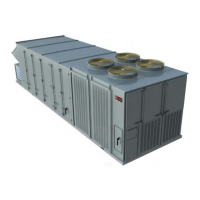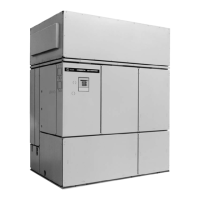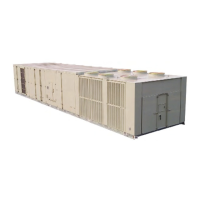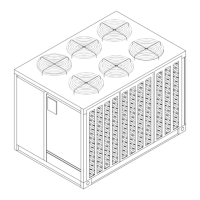100
SCXF-SVX01Q-EN
4. Check the condition and tension of fan belts. Adjust
tension if belts are floppy or squeal continually.
Replace worn or fraying belts in matched sets.
NNoottee:: Check belt tension and adjust it at least twice
daily the first days of new belt operation. Belt
tension will rapidly decrease until the belts
are run in.
5. Check the liquid line sight glasses during operation.
Bubbles in the sight glasses indicate a possible
shortage of refrigerant or an obstruction in the
liquid lines, e.g. dirty liquid line filter driers.
6. Inspect filter driers for leaks, flow obstructions, or
temperature drop across the filter drier. A
noticeable temperature differential, e.g. 5°F, in the
liquid line may indicate an obstruction. Replace the
filter drier if it appears clogged.
7. Inspect the optional waterside economizer coil.
Clean the coil to prevent airflow restrictions
through the fins.
8. Check and record operating pressures.
Semi-Annual Maintenance
1. Verify the fan motor is properly lubricated. Follow
lubrication recommendations on the motor tag or
nameplate. Contact the motor manufacturer for
more information.
2. Lubricate fan bearings. For best results, lubricate
bearings during unit operation. Refer to the “Fan
Bearings” section for recommended grease.
NNoottee:: The bearings are manufactured using a
special synthetic lithium-based grease
designed for long life and minimum lube
intervals. Over lubrication can be just as
harmful as not enough.
3. With power disconnected, manually rotate the fan
wheel to check for obstructions in the housing or
interference with fan blades. Remove obstructions
and debris. Center the fan wheel if necessary.
4. Check the fan assembly sheave alignment. Tighten
set screws to their proper torques.
5. Check water valves for leakage at valve stem
packing nut.
NNoottee:: Perform this procedure monthly if the unit is
in a coastal or corrosive environment.
Annual Maintenance
Check and tighten all set screws, bolts, locking collars
and sheaves.
1. Inspect, clean, and tighten all electrical connections.
2. Visually inspect the entire unit casing for chips or
corrosion. Remove rust or corrosion and repaint
surfaces.
3. Visually check for leaks in refrigerant piping.
4. Inspect fan, motor, and control contacts. Replace
badly worn or eroded contacts.
5. Inspect the thermal expansion valve sensing bulbs
for cleanliness, good contact with the suction line,
and adequate insulation from ambient air.
6. Verify the superheat setting is 12 -17°F at the
compressor.
When checking operating pressures and conditions,
establish the following nominal conditions for
consistent measurements.
• Leaving air temperature greater than 60°F
• Entering air temperature is 80 - 90°F
• Entering water temperature greater than 65°F
• Compressors running at full load
• Drain the condensing water system and inspect it
thoroughly for fouling; clean if necessary.
MMaaiinntteennaannccee
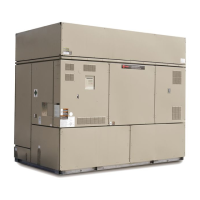
